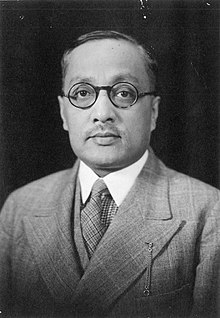Biratnagar
[12] As per the preliminary report of 2022 Nepal census, Biratnagar Metropolitan has an estimated city population of 243,927 excluding the suburban areas which are now very well connected to the old town.
It is the administrative center of the Greater Birat Development Area which incorporates the cities of Biratnagar and its suburbs and towns of-Itahari-Gothgau-Biratchowk-Dharan[13] primarily located on the Koshi Highway in Eastern Nepal, with an estimated total urban agglomerated population of 804,300 people in 159,332 households including the town of Ithari.
Biratnagar was declared a metropolitan city on 22 May 2017,[15] a merger with additional wards pushing the total population to over 240,000.
[21][22] In 1914, Colonel Jit Bahadur Khatri, the then district governor, laid the foundations of modern Biratnagar by moving the hospital, post office, prison and the customs, land registry, forestry and auditor offices to Gograha Bazaar from Rangeli, the then district capital of Morang.
[24] The recorded history of Biratnagar dates back to the beginning of the 7th century, when King Mung Mawrong Hang came to prominence in the terai lands of Limbuwan (present-day Sunsari, Morang, and Jhapa areas).
The ruins of temples, palaces, and ponds are scattered in a vast area to the south of the current city, in Vedhyari, Buddhanagar.
The town was named Biratnagar in 1919 (1976 BS) by Keshar Shamsher Rana after the ruins of a palace, thought to be of King Virat (not proved), and other objects of historical importance were found.
According to the Markandeya Purana, the famous seven Kirata kingdoms during the Mahabharat time were Aswakut or Kabul, Kulya or Kulu Valley, Matsya or North Bihar Paundra or Bengal, Sumer or Assam, Malak or Mlek or Lohit, Kinner Kirat or Garhwal and Nepal.
In those days, the Kirat people were ruling all the lands from Himalayan Mountains to the sea shores of the Bay of Bengal.
[31] In terms of ethnicity/caste, 18.7% were Hill Brahmin, 10.0% Chhetri, 8.3% Musalman, 5.2% Yadav, 4.6% Newar, 3.6% Kewat, 3.3% Marwadi, 2.9% Dhanuk, 2.8% Teli, 2.8% Tharu, 2.6% Mallaha, 2.6% Rajbanshi, 2.2% other Terai, 2.0% Musahar, 1.8% Halwai, 1.6% Kathabaniyan, 1.5% Kayastha, 1.4% Sudhi, 1.3% Nuniya, 1.2% Dusadh/Paswan/Pasi, 1.2% Magar, 1.2% Rai, 1.0% Bengali, 1.0% Tamang, 0.9% Hajam/Thakur, 0.8% Kalwar, 0.8% Rajput, 0.7% Bantar/Sardar, 0.6% Chamar/Harijan/Ram, 0.6% Gurung, 0.6% Kami, 0.6% Koiri/Kushwaha, 0.6% Sanyasi/Dasnami, 0.6% Tatma/Tatwa, 0.5% Terai Brahmin, 0.5% Kurmi, 0.5% Limbu, 0.5% Sonar, 0.4% Badhaee, 0.3% other Dalit, 0.3% Dhobi, 0.3% Dom, 0.3% Gangai, 0.3% Gharti/Bhujel, 0.3% Jhangad/Dhagar, 0.3% Khatwe, 0.3% Majhi, 0.3% Punjabi/Sikh, 0.2% Badi, 0.2% Baraee, 0.2% Damai/Dholi, 0.2% Dev, 0.2% Khawas, 0.2% Sarki, 0.2% Thakuri, 0.1% Amat, 0.1% Bantawa, 0.1% Bin, 0.1% Chamling, 0.1% Danuwar, 0.1% Dhimal, 0.1% foreigners, 0.1% Gaderi/Bhedihar, 0.1% Halkhor, 0.1% Kahar, 0.1% Kumal, 0.1% Kumhar, 0.1% Lohar, 0.1% Satar/Santal, 0.1% Sunuwar, 0.1% Yakkha and 0.2% others.
Biratnagar is connected to a major custom route with India and has the second-largest land port in Nepal.
Biratnagar is a hub for explorers of places in eastern Nepal like Ilam, Taplejung, Sankhuwasabha and Panchthar.
The hijack plan, masterminded by Girija Prasad Koirala, was executed by Durga Subedi, Nagendra Dhungel and Basant Bhattarai.
Biratnagar has been the ground for many prominent literary personalities like, Bishweshwar Prasad Koirala, Tarini Prasad Koirala, Dev Kumari Thapa, Bal Krishna Pokharel, Parashu Pradhan, Krishna Bhooshan Bal, Dadhiraj Subedi, Bibas Pokharel, Suman Pokhrel, Bhola Rijal, Bhuwan Dhungana and others.
Landmark books in Nepali poetry, Bholi Basne Bihan by Krishna Bhooshan Bal and Jeevanko Chheubaata by Suman Pokhrel were first published in this city.
[42] This theatre group has produced dozens of theatrical plays including Agniko Katha and Yajnaseni and has got them performed across the countries.
At present day, Aarohan Gurukul is considered as one of the major places of public attraction in Biratnagar.
Other facilities in the city include lawn tennis and basketball courts Nabin Kumar Shrestha (actor)








